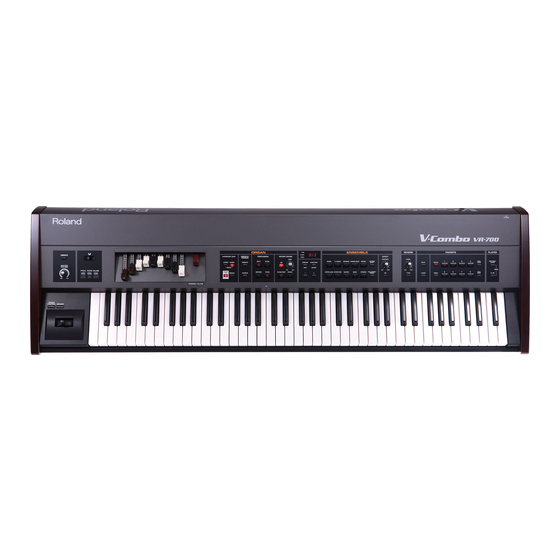
Roland V-Combo VR-700 Workshop
Splits and layers
Hide thumbs
Also See for V-Combo VR-700:
- Owner's manual (84 pages) ,
- Workshop (13 pages) ,
- Quick start manual (4 pages)
Summary of Contents for Roland V-Combo VR-700
- Page 1 Workshop ®ÂØÒňΠ® V-Combo VR-700 V-Combo Splits and Layers © 2010 Roland Corporation U.S. All rights reserved. No part of this publication may be reproduced in any form without the written permission of Roland Corporation U.S. VR700WS02...
- Page 2 About the V-Combo VR-700 Workshop Booklets In a Hurry? The Roland V-Combo VR-700 Stage Keyboard is designed for the working This booklet discusses splits and layers in detail. If you prefer, though, you musician, bringing together all the tools a gig demands. Roland’s acclaimed...
- Page 3 Here’s a way to visualize the V-Combo’s organ sounds: What Are Splits and Layers? Splits and layers allow you to use V-Combo sounds together. With a • split—you divide the keyboard into two zones, each of which plays its own sound(s). For the V-Combo’s organ sounds, splitting the keyboard Organ Upper Manual allows you to treat its two zones as upper and lower manuals.
- Page 4 Playing Single Sounds Across the Whole Keyboard If the HARMONIC BAR ORGAN ON button is lit, press it once to turn it off. Playing the V-Combo as a Single-Manual Organ To adjust the level of the ensemble tone without changing the V-Combo’s overall volume, use the ENSEMBLE VOLUME drawbar—if you save the tone as a Favorite, this setting will be remembered for you.
- Page 5 Hold down the tone-category button you selected in Step 3, and If you’re not using a pedal keyboard and would prefer the characteristic press TO LOWER/PEDAL once—the SPLIT button lights, and the pedal sound under your left hand instead of the lower manual, hold second ensemble tone now occupies the lower area of the keyboard.
- Page 6 To adjust the overall level of your layered sound—without affecting To select a different ensemble tone, press a different tone-category their volumes relative to each other—use the ENSEMBLE VOLUME button and use the - and/or + buttons to select the tone you want. drawbar instead of the MASTER VOLUME since it’ll be stored along with To change the organ sound, make sure that only the UPPER HARMONIC the rest of your setup if you save it as a Favorite.
- Page 7 Press the desired tone-category button—the tone-category button While holding down the button you pressed in Step 1, press the lights red—and then use the - and/or + buttons to select the desired category button for the second ensemble tone you want to use—the tone in that category as Ensemble Tone 1.
- Page 8 Creating an Organ and Two-Ensemble-Tone Split To adjust the overall level of your layered sound—without affecting their volumes relative to each other—use the ENSEMBLE VOLUME drawbar instead of the MASTER VOLUME, since it’ll be stored along with the rest of your setup if you save it as a Favorite. Organ Upper Manual Ensemble Tone 1 Getting Fancy...
- Page 9 Creating a Two-Keyboard Dual Manual Organ Configure the V-Combo On the V-Combo: One of the most enjoyable ways to unleash the V-Combo’s power is to Press the FUNCTION button beneath the display—”Fnc” appears connect a second MIDI keyboard—purchased separately—to the V-Combo onscreen.
- Page 10 The End We hope you’ve found this workshop helpful. Keep an eye out for other V-Combo Workshop booklets available for downloading at www.RolandUS.com.













Need help?
Do you have a question about the V-Combo VR-700 and is the answer not in the manual?
Questions and answers